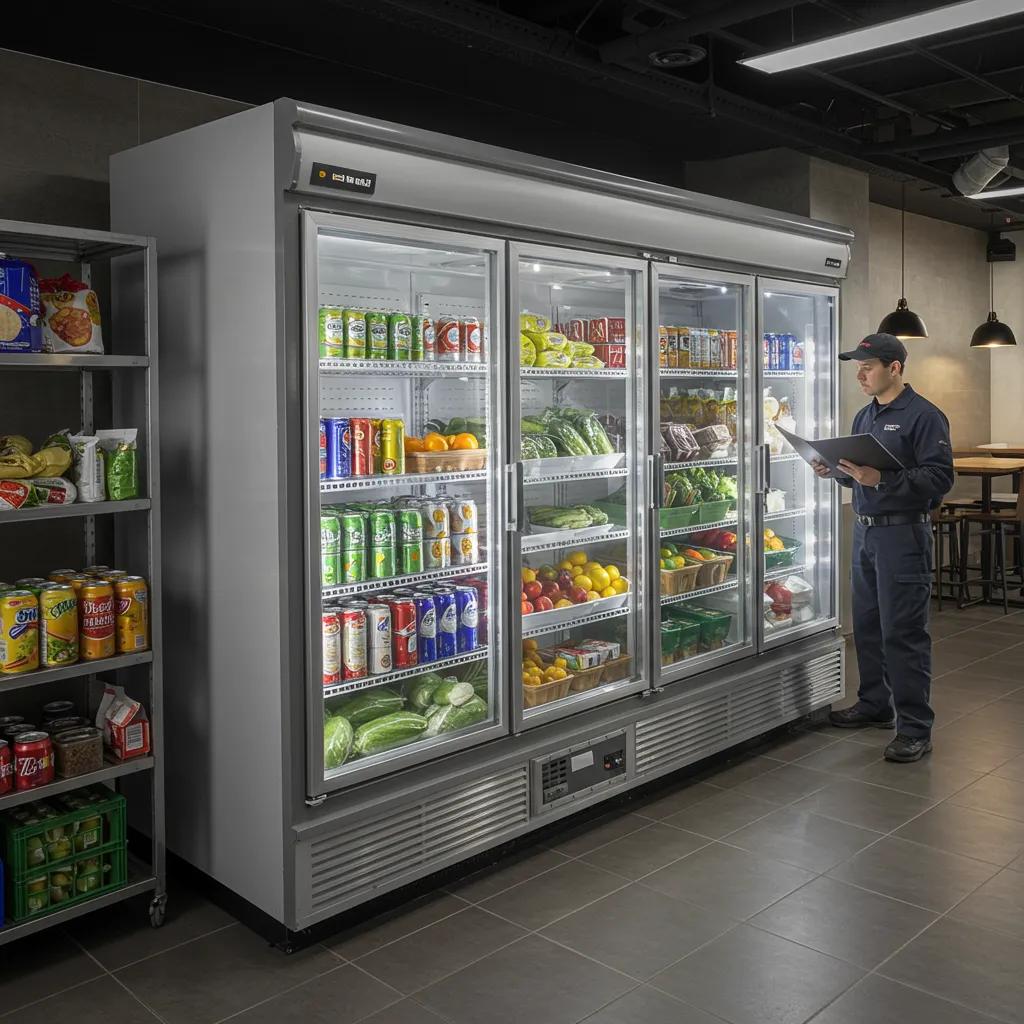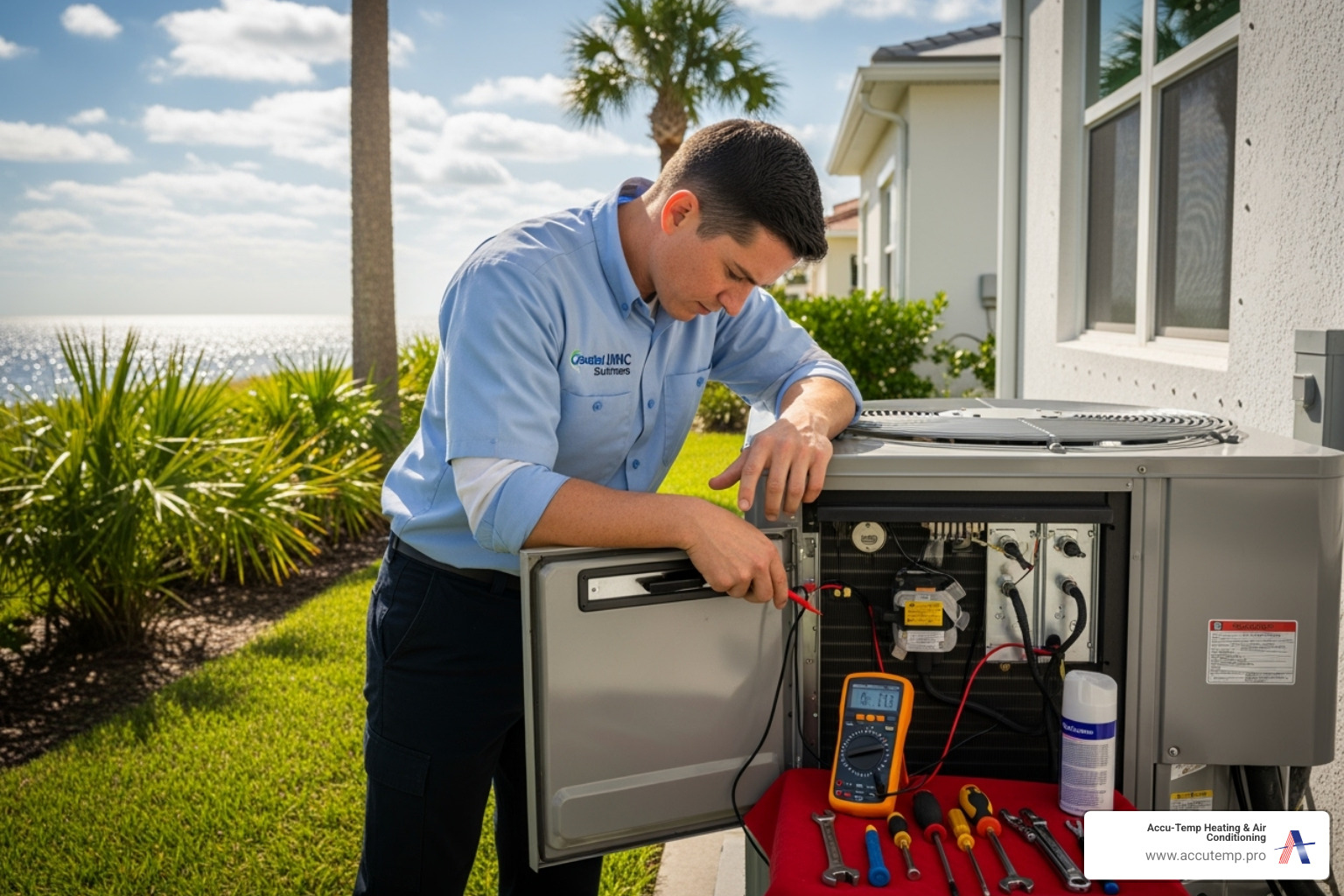Why Your AC Not Cooling is More Than Just an Inconvenience
When your AC not cooling during Florida’s sweltering heat, it’s more than an inconvenience—it can be a health and safety risk. You come inside expecting cool relief, only to feel warm air blowing from your vents.
Quick Answer: Most Common Causes of AC Not Cooling
- Dirty air filter – blocks airflow over evaporator coil
- Thermostat issues – wrong settings or dead batteries
- Tripped circuit breaker – cuts power to outdoor unit
- Frozen evaporator coils – from restricted airflow
- Low refrigerant – usually indicates a leak
- Blocked outdoor unit – debris prevents heat transfer
- Dirty condenser coils – can’t release heat effectively
Fortunately, many of these issues have simple DIY fixes. Others require a professional to avoid safety risks or further damage.
Your AC moves refrigerant between indoor and outdoor coils to transfer heat from your home to the outside. A breakdown in this cycle results in warm air instead of the cool comfort you need.

Simple DIY Checks You Can Perform in 5 Minutes
Before worrying about expensive repairs, know that many AC not cooling issues are simple DIY fixes. These quick checks can often save you a service call and cover the most common culprits: thermostat settings, power supply issues, and outdoor unit problems.

Often, the issue is just a wrong thermostat setting or a tripped circuit breaker. Spend five minutes on these checks before calling for help. For additional guidance, our 5 HVAC Troubleshooting Tips covers even more basics every homeowner should know.
Check Your Thermostat Settings
Your thermostat controls your cooling system. Start by making sure it’s set to “COOL” mode and the target temperature is at least 5 degrees below the current room temperature. It’s easy to accidentally switch it to “HEAT” mode, which will quickly make your home uncomfortable in Florida’s climate.
Next, check the fan setting. If it’s set to “ON,” the fan runs constantly, even when not cooling, which can make it seem like the AC is broken. Switch it to “AUTO” so the fan only runs during actual cooling cycles.
If the digital display is blank, try replacing the batteries (usually AA or AAA). Dying batteries can cause the entire system to become unresponsive.
Having thermostat wiring issues? Here’s more on wiring a thermostat for deeper troubleshooting.
Inspect Your Circuit Breaker and Power
Your AC needs power to work. An electrical issue is often the source of an AC not cooling.
Check your electrical panel for tripped breakers (in the middle or “OFF” position). To reset, flip the breaker fully to “OFF,” then back to “ON.” If the breaker trips again, stop resetting it. This indicates a serious electrical problem that needs a professional.
Also, check the power disconnect box near your outdoor unit to ensure the switch is “ON.” Landscapers or children can sometimes turn these off by accident.
Blown fuses can also be an issue in older homes. Check for any fuses that appear burned out.
Want to understand why your system might be having electrical problems? Our guide on AC Tripping the Circuit Breaker explains the most common causes. For more technical details, here’s what to know about circuit breakers.
Examine the Outdoor Condenser Unit
Your outdoor condenser unit releases heat from your home. If it’s blocked by debris or dirt, it can’t function properly.
Ensure there are at least 18-24 inches of clear space around the unit, free of grass clippings, leaves, or overgrown plants. A blocked unit cannot cool effectively.
Dirty condenser coils (the metal fins) prevent proper heat transfer, a common reason for an AC not cooling. You can gently clean the coils with a garden hose, spraying from the inside out. Be careful not to bend the delicate metal fins, as this will restrict airflow.
Pro tip: Never use a pressure washer on your condenser coils, as the high pressure can damage the fins.
For a deeper dive into how dirty coils affect your system, check out our article on how Dirty AC Condenser Coils Impact Performance.
Common Reasons for an AC Not Cooling and How to Fix Them
If the quick checks didn’t work, it’s time to look at more complex issues. The most common culprits behind an AC not cooling involve airflow problems, refrigerant issues, or the system’s inability to transfer heat.
When one component is clogged, dirty, or leaking, the whole system suffers. These are the issues we see most often when homeowners in Palm Coast, Daytona Beach, and throughout Florida call us about a malfunctioning AC.
For a comprehensive look at what might be going wrong, check out our detailed guide on 8 Possible Reasons Behind AC Not Cooling Properly.
A Dirty or Clogged Air Filter
A dirty air filter is the most common cause of an AC not cooling, and it’s the easiest and cheapest to fix. The filter protects your system from dust, pet hair, and other debris.
When the filter is clogged, restricted airflow leads to reduced cooling, system strain, and higher energy bills. It can also cause the evaporator coil to freeze up.
The simple fix is to check your filter monthly during cooling season (more often with pets) and replace it if it’s dirty. Your AC and your wallet will thank you. Learn more about How to Clean an HVAC Filter and understand the Importance of a Good Filter.
Frozen Evaporator Coils
A frozen evaporator coil is a clear sign of a serious airflow or refrigerant problem. This happens when the coil gets too cold due to blocked airflow (from a dirty filter or closed vents), causing moisture to freeze on it. This ice further blocks airflow in a vicious cycle.
Signs of frozen coils include warm air (or no air) from vents, visible ice on refrigerant lines, hissing sounds, and water leaking from the indoor unit as the ice melts.
If you suspect frozen coils, turn off your AC immediately. Set the thermostat to “FAN ON” to help thaw the ice, which can take several hours. Do not chip away the ice, as this can damage the coils.
Once thawed, replace the air filter and ensure all vents are open before restarting. For step-by-step guidance, check out What Do I Do If My AC Coil Is Frozen? and Why There Is Ice on Your Air Conditioner and How to Fix It.
Refrigerant Leaks: A Serious Cause for an AC Not Cooling
Refrigerant is the chemical that allows your AC to move heat. Your AC is a closed system; it doesn’t use up refrigerant. Low levels mean there is a leak.
Refrigerant leaks are a major cause of an AC not cooling. Signs of a leak include hissing or bubbling noises and warm air from the vents while the system is running. Low refrigerant can also cause the evaporator coil to freeze or leave an oily residue on refrigerant lines.
Refrigerant is a hazardous chemical. If you suspect a leak, call a professional immediately. Simply adding more refrigerant (a “recharge”) without fixing the leak is a temporary, expensive fix that doesn’t solve the underlying problem.
A qualified technician can locate and repair the leak, then recharge your system to the correct level. For more details, read about AC Refrigerant Leak Signs and What Do I Do If I Have an AC Leak?.
Leaky or Blocked Ductwork
Duct problems can prevent cool air from reaching certain rooms, causing your AC not cooling in specific areas.
Leaky ducts are common, especially in older homes. Loose connections and deteriorating seals allow cooled air to escape into attics or crawl spaces, wasting energy.
Blocked ducts and vents can be caused by furniture, rugs, or even debris and pests inside the ductwork, all of which reduce airflow.
Signs include weak airflow from some vents, uneven cooling, and hot and cold spots in your home. While you can check for obvious blockages, hidden ductwork problems require professional assessment and repair. Learn more about how Blocked Air Vents Impact Cooling Efficiency, and consider a professional Air Duct Cleaning Service for significant blockages.
When to Call a Professional: Issues Beyond a Simple Fix
Some AC problems are too complex or dangerous for DIY fixes and require an expert. These issues often involve electrical components or heavy machinery, and attempting these repairs yourself can be dangerous and lead to costlier damage. When your AC not cooling is due to these issues, call a professional.
Working with electrical components is a safety risk and can void your warranty. A certified HVAC technician has the tools and training to resolve these issues safely. If you’re wondering how to choose the right professional, our guide on How to Choose the Right Air Conditioner Repair Company can help.
Electrical Failures: Capacitors and Contactors
Two common electrical failures involve the capacitor and the contactor.
The capacitor provides the jolt of electricity needed to start your AC’s motors. A humming outdoor unit that won’t start, a fan that won’t spin, or a clicking sound can all point to a failing capacitor.
What is a capacitor? Over time, these can fail, especially in Florida’s heat. Our article on Signs Your AC Capacitor Is Failing can help you identify the problem.
The contactor is a switch that sends power to the outdoor unit. If it fails, the indoor unit may run, but the outdoor unit will be silent.
Replacing these parts is not a DIY job and requires a professional to avoid electrical shock and further damage.
Faulty Compressor or Fan Motor
If simpler fixes don’t work, the issue could be a faulty compressor or fan motor.
Your compressor is the heart of your AC, circulating refrigerant to transfer heat. A faulty compressor means your AC not cooling at all. Signs of a faulty compressor include grinding or squealing noises, difficulty starting, or the system running with no cold air. Our article on AC Compressor Grinding Noises can help you identify these sounds.
Your AC has two main fan motors: an indoor blower and an outdoor condenser fan. A faulty outdoor fan can cause the compressor to overheat. A broken indoor fan means no cool air circulates in your home. Grinding, buzzing, or squealing noises often indicate a failing motor. To help identify these sounds, check out Why is my AC unit making loud noises?.
These are complex components that require professional replacement. If you suspect an issue, call a technician to diagnose the problem and recommend the best course of action.
Incorrectly Sized AC Unit
Sometimes, the issue is an incorrectly sized AC unit. An AC not cooling properly or running constantly can be a sign of a sizing mismatch.
An undersized unit will run constantly, leading to high energy bills and premature wear, without ever properly cooling your home.
An oversized unit will “short cycle”—cooling too quickly and shutting off. This prevents it from properly dehumidifying the air, leaving your home feeling cool but clammy. Short cycling also causes excessive wear on components.
Proper sizing requires a professional load calculation based on your home’s size, insulation, windows, and other factors. If your home has been renovated or you’ve recently moved in, the unit may no longer be the right size.
Our articles on Size Matters When Selecting an Air Conditioner and How to Calculate What Size AC You Need provide more insight into this crucial aspect.
Frequently Asked Questions about AC Cooling Problems
Here are answers to the most common questions we hear about AC not cooling issues in the Palm Coast to Daytona Beach area.
Why is my AC running but not lowering the temperature?
This is a common complaint. The most common causes are a dirty air filter restricting airflow, low refrigerant due to a leak, or dirty condenser coils on the outdoor unit preventing heat release. Also, check for incorrect thermostat settings or frozen evaporator coils, which completely stop cool air production.
For a comprehensive look at this specific issue, check out our detailed guide on Why is my AC not cooling enough?.
Should I turn my AC off if it’s not cooling?
Yes. Continuing to run a malfunctioning AC when it’s not cooling can cause more significant and expensive damage. It puts immense strain on the compressor, the most expensive component. An overheated, failed compressor is a costly repair.
If the coils are frozen, running the AC will worsen the ice buildup and can lead to water damage when it melts. An inefficient AC also wastes electricity and money.
Turn off your system, troubleshoot with the simple checks, or call a professional. If you’re dealing with an urgent situation, our emergency guide on AC Repair Emergency: What to Do can walk you through immediate steps.
How can I prevent my AC from failing in the future?
Preventative maintenance is the best way to avoid an AC not cooling emergency. Most failures are preventable with regular attention.
Change air filters regularly. Check them monthly during peak cooling season, as a clean filter is the easiest way to prevent major repairs.
Keep your outdoor unit clear of debris and vegetation. Maintain at least 18-24 inches of clearance on all sides for proper airflow.
Schedule professional tune-ups annually. A technician will clean coils, check refrigerant, inspect electrical parts, and catch minor issues before they become major problems. Annual maintenance is often required to keep your warranty valid.
A little attention goes a long way in preventing a summer breakdown. Our Air Conditioning Maintenance Services are designed for Florida’s climate. Learn more in our guide to Understanding AC Preventative Maintenance.
Get Your Cool Air Back with Expert Help
When your AC not cooling, it’s time for action. While some issues are simple DIY fixes, others require a professional. Refrigerant leaks, electrical failures, and compressor issues are complex and can be dangerous to handle without proper training.
In Florida’s heat, a working AC is essential for your family’s health and safety. When your system fails, you need fast, reliable help.
At Accu-Temp Heating & Air Conditioning, we understand the urgency. As a family-owned business serving the Palm Coast to Daytona Beach area, our experienced technicians can quickly diagnose and fix your cooling problems. We offer comprehensive HVAC solutions, from AC repair to indoor air quality improvements, all backed by our 100% satisfaction guarantee and competitor quote matching.
If you’ve tried these troubleshooting steps and still have warm air, it’s time to call the professionals. Don’t spend another sweltering day with an AC that isn’t doing its job.
Ready to restore your home’s comfort? Schedule your AC replacement in Palm Coast, FL or contact us today for expert repair services that will have you enjoying cool, refreshing air again in no time.








